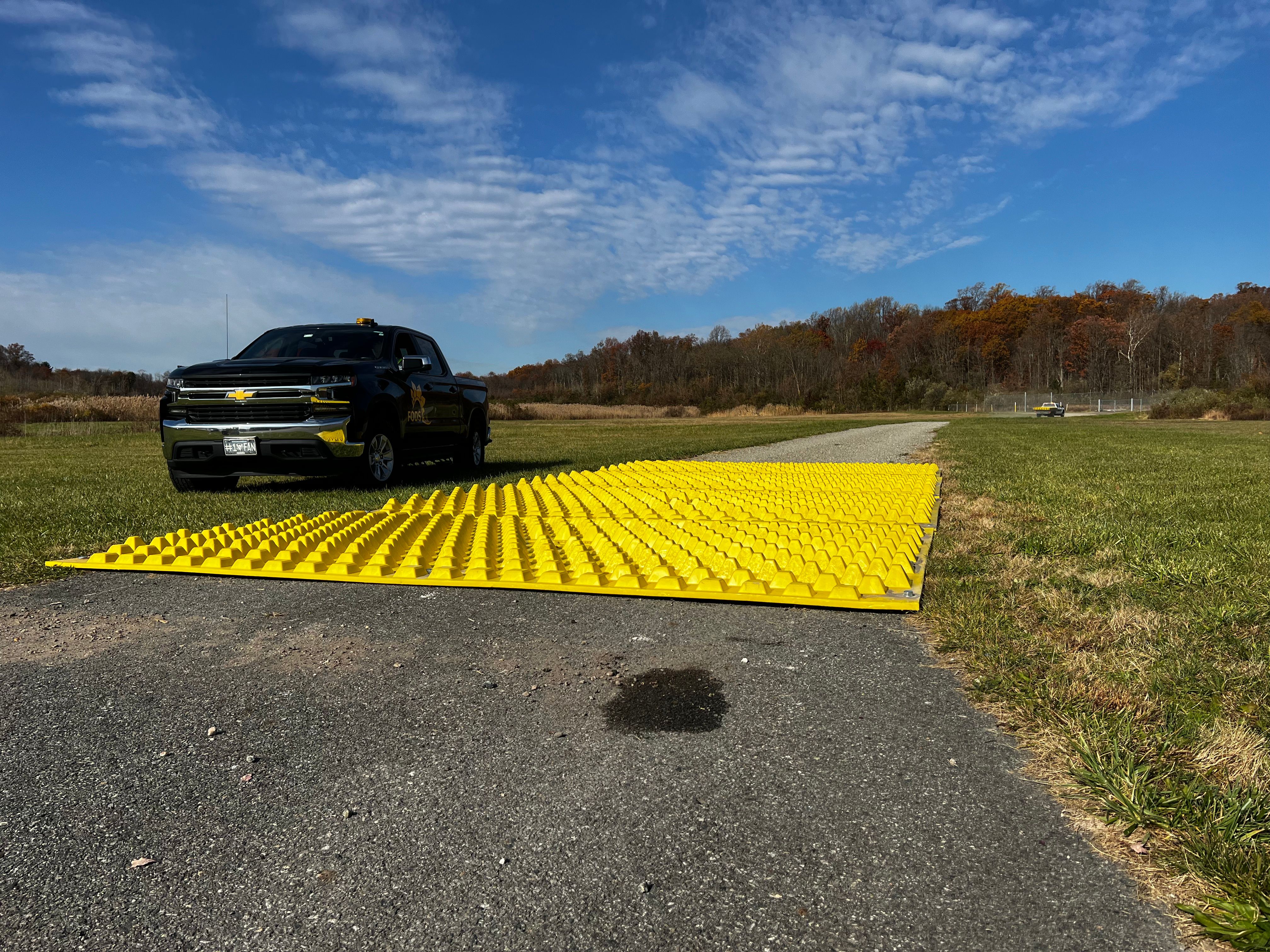New Jersey Stabilized Construction Access Detail
As one of the original Thirteen Colonies, New Jersey was the site of many foundational moments the nation’s history which are preserved at Morristown National Historical Park.
Being one of the oldest and most developed states, New Jersey is home to the Port of New York and New Jersey which is the busiest shipping port on the eastern coast. The major port combined with the second most dense rail and road network in the country provides the perfect combination for distribution services including ten Amazon distribution centers which serve customers across the state and the nearby hubs of New York City and Philadelphia. Besides the logistics services economy, advanced manufacturing, and pharmaceutical research make up the major industries in the state.
New Jersey Stormwater Permit Program (NJPDES)
The Division of Water Quality of the New Jersey Department of Environment Protection (DEP) administers the Federal Clean Water Act to maintain high water quality for the states nearly 9 million residents. The Division outlines Green Infrastructure (GI) methods which are used to guide new development in order to reduce runoff and reuse stormwater. The primary policy regulating discharge into the surface waters of the state is the New Jersey Pollution Discharge Elimination System (NJPDES) Program. The NJPDES Program requires that all Industrial, Construction and Municipal entities obtain a stormwater permit before discharging into rivers, lakes or coastal watersheds. The conditions of the permit are such that pollution is properly mitigated before the discharges occur, and therefore, the pollutants are contained before entering the surface waters.
The Division of Water Quality has established Stormwater Management Rules which apply to all new construction projects that disturb an area of one or more acres. Many construction projects can obtain coverage through the general Construction Activities (5G3) General Permit (NJ0088323) which is issued through the Local Soil Conservation Districts. To obtain coverage under the general construction stormwater permit, contractors must develop a soil erosion and sediment control plan which is designed to implement measures to minimize the flow of contaminated runoff into surface waters. The NJDEP maintains an online portal for stormwater permitting called the Stormwater Construction E-Permitting System.
The development of the Soil Erosion and Sediment Control Plan involves identifying potential sources of pollution on the construction project and defining which techniques are used to mitigate pollution or contain sediment laden runoff before it can enter surface waters. Each of these techniques are called Best Management Practices (BMPs). The BMPs used are designed to meet the minimum standards and maintain sedimentation below the required effluent limits. The Standards for Soil Erosion and Sediment Control in New Jersey contains detailed descriptions of common BMPs to guide contractors and engineers as they decide which techniques to implement on their projects. The Stormwater Best Management Practices Guide also includes information about the techniques used to stabilized the site and contain runoff.
Stabilized Construction Accesses
One of the first BMPs to be installed at a job site is the Stabilized Construction Access. The technique aims to reduce the off-site sediment tracking from construction vehicles as they leave disturbed areas. Stabilized Construction Accesses are installed at every point in ingress/egress where vehicles exit onto paved roads, concrete, or other impermeable surfaces. The Standards indicate that the technique prevents a significant amount of hydrocarbon pollution that originates from oils, fuels, and grease that becomes mixed into the soil. All entrances which are not stabilized should be blocked to prevent use from construction vehicles.
A common and traditional type of BMP that is used to prevent off-site sediment tracking is the Stone Access Drive. The Standards include criteria for the design of the stone pad. The depth of gravel must be at least 6” and use ASTM C-33 size Number 2 (1 1/2” to 2 1/2”) or Number 3 (1” to 2”) stone. The stone should be crushed stone which includes angular features, but crushed concrete may be substituted (crushed concrete may require more frequent maintenance).
Each pad must be as wide as the ingress/egress area and should be a minimum of 50’ in length when the soil is course and includes sand and gravel. The entrance should be a minimum of 100’ in length if the soil is fine grain and includes silt and clay. All drainage from surrounding areas should be diverted away from the the stabilized construction entrance. On step slopes (above 5%), a bed of asphalt should be installed beneath the stabilized entrance. A geotexile may be installed when there is poor drainage where the entrance is installed.
As the job progresses and internal roads are paved or permanently stabilized, individual lots may be allowed to implement a shorter length entrance (minimum of 10’) for the duration of the development.
The Stabilized Construction Access points will require maintenance. The contractor must keep the entrance in a condition so sediment is effectively contained on-site. As traffic deposits sediment and debris into the rock drive, it may become compacted and require top dressing with additional stone or increasing the length of the entrance. Any sediment tracked or spilled onto the impervious surface should be removed immediately using a power broom or street sweeper.
Other methods may be required in addition to the rock entrance if sediment is not sufficiently contained. One method that is used to supplement the stone access drive is a Tire Wash. A Tire Wash uses pressurized water to spray mud and debris off vehicle tires. When a tire wash is installed, adequate techniques must be used to contain the runoff from the Tire Wash to prevent sediment from entering the street.
Two risks associated with rock must be accounted for as well. The first is aggregate from the Stabilized Construction Access tracking onto active roadways which can be mitigated by paving a transition area between the rock pad and the active roadway. Another risk is when aggregate becomes lodged between dual tire vehicles and expelled at high speeds. Dual tire vehicles or vehicles with large tire treads must be accounted for when selecting the rock size. The use of larger diameter gravel will reduce the risk of rock becoming lodged in dual tire vehicles or large tire treads.
FODS Reusable Stabilized Construction Entrance System
One modern approach to mitigating sediment tracking from construction vehicles is the FODS Trackout Control System. This technique is effective, and low cost while also reducing the risks of aggregate entering roadways. The FODS Trackout Control System is 100% manufactured in the USA and can be recycled at the end of the product’s 10+ year service life.
The system consists of HDPE mats which have pyramid shaped features throughout the surface. The pyramids deform vehicle tires and allow sediment trapped between tire treads to break loose. The voids between the pyramids allow sediment to safely collect without coming into contact with vehicle tires. The mats are easily maintained by a simple cleaning as the pyramids fill with sediment. Contractors commonly complete maintenance using a power broom, street sweeper or a FODS shovel.
The entrance can be installed over any substrate and does not introduce rock to the egress points reducing risk of aggregate entering active roadways. The entrance is durable and designed to be reused for the 10+ year lifespan of the product allowing contractors to reduce costs while maintaining compliance on multiple projects.
The FODS Trackout Control System is more effective than traditional stone access drive and has been demonstrated to reduce street sweeping by up to 59%. The system is portable and extremely durable allowing for repeated use through multiple phases of construction projects and use on multiple projects. Phased projects such as highway construction can benefit form the reusability and the reduced risk of introducing aggregate into the active roadways. In addition, the system can be installed over asphalt, concrete or directly on grade enabling versatile applications in urban applications.
Additional Resources
Construction Activities (5G3) Permit
NJ Standards for Soil Erosion and Sediment Control
Stormwater Best Management Practices Guide
Green Infrastructure (GI) Resources
NJ Stormwater Best Management Practices Manual

